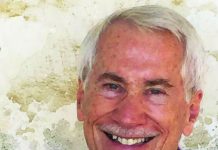
An explosion of happiness last Saturday night. Laguna Beach High won its first CIF football sectional championship since 1946. It had been a long wait. Pictures of the team with their trophy captured the joy of youthful victory. Micah Chavez, who scooped up a blocked punt to score his first touchdown, said it best by saying nothing. “I’m feeling so great. I don’t even know what to say.”
After the game, Coach John Shanahan shared an 8-by-10 photo of that 1946 squad. It was a poignant look back; those who might still be alive would be in their mid-nineties now. I made a note to track those players down, thinking there might be a good story. Then one name came to mind— Weston David Balfour.
Weston, a stand-out running back for Laguna High, wasn’t on the ’46 team. He graduated in 1940. And he wasn’t alive for that first championship, which leads to a story. After graduating, Balfour played for the old Santa Ana Junior College (today, Santa Ana College), then joined the U.S. Army Air Force. During this time, Laguna Beach was used by Hollywood studios to film movie scenes and his enlistment form gave his occupation as “actor.” He was stationed at March Air Force Base and was assigned to the 693rd Ordnance Company Aviation. Balfour was there when Bob Hope made the first of a lifetime of USO shows for our armed forces.
In response to Japanese military aggression in the Asia-Pacific region, Weston’s group was moved to the Philippines. It was a fateful move. The Japanese attacked Pearl Harbor on Dec. 7, 1941, a day President Franklin D. Roosevelt declared would “live in infamy.” (This coming Wednesday marks the 81st anniversary.) The following day, Dec. 8, Japan invaded the Philippines, and though our numbers were greater, the invaders were elite troops, well-equipped and tested in prior campaigns. Despite heroic resistance, the Philippines fell five months later.
Weston survived the battle, the infamous Bataan Death March, which followed, and two-and-a-half years of hard labor in POW camps. In October 1944, the U.S. Army and Navy began a campaign to retake the Philippines. As the campaign progressed, Japan, seeing future use for the POWs, began to pack them into ships returning to Japan. Balfour and 750 fellow prisoners were loaded into the freighter, “Shinyo Maru.” The U.S. Navy had a picket line of submarines surrounding the Philippines, and the submarine “USS Paddle” sighted the freighter. Unaware the freighter contained POWs, it sank her with two torpedoes. Of the 750 POWs, just 83 survived the sinking and could swim back to shore. Within a few days, they were rescued by advancing U.S. forces.
Sadly, after all, he had endured, Balfour was not among the survivors. In 1975, I assisted at a funeral for Laguna resident John David Balfour. I didn’t know him, I was covering for his minister who couldn’t be there, but at the funeral, I learned of his life and the sad loss of a son during World War II—Weston. The father had never really gotten over the death of his son. A loss made even more painful when the family later learned how close Weston Balfour had come to surviving his ordeal. For Weston, there was no victorious homecoming. No wife, child or grandchild would ever call his name. No grave marks his passing; his body remains within the restless sea.
Yet, in the way that all flesh must return to nature, Weston has surely come home, his essence borne to our beaches by the timeless gyre of ocean currents. Welcome home, Weston. You’re remembered and honored. The things you fought for have survived. And your alma mater has recently continued the sport you loved with great success. There’s meaning in that.
Skip fell in love with Laguna on a ‘50s surfing trip. He’s a student of Laguna history and the author of “Loving Laguna: A Local’s Guide to Laguna Beach.” Email: [email protected].




